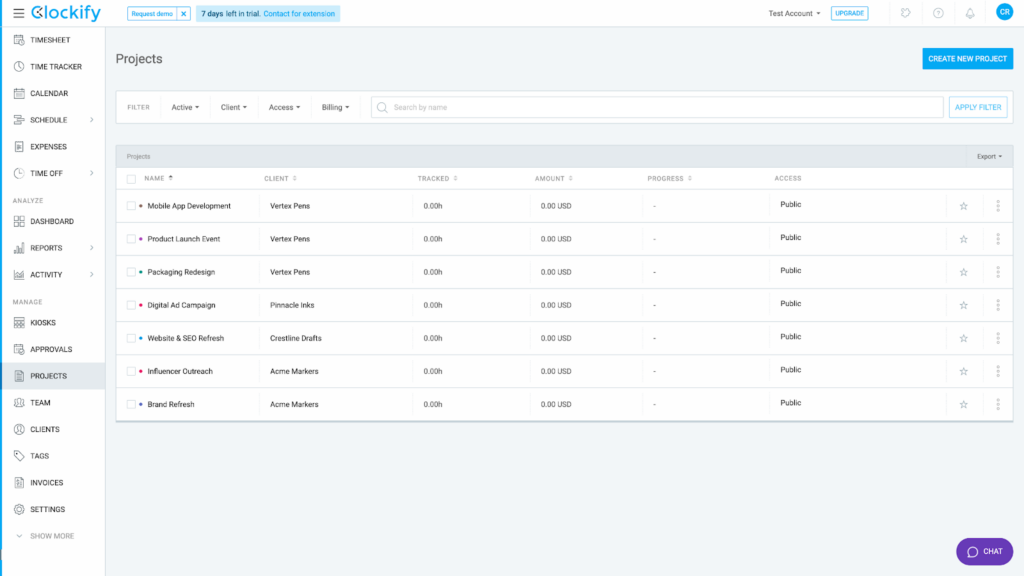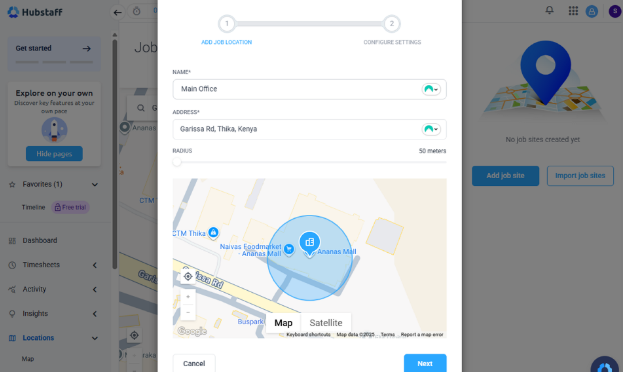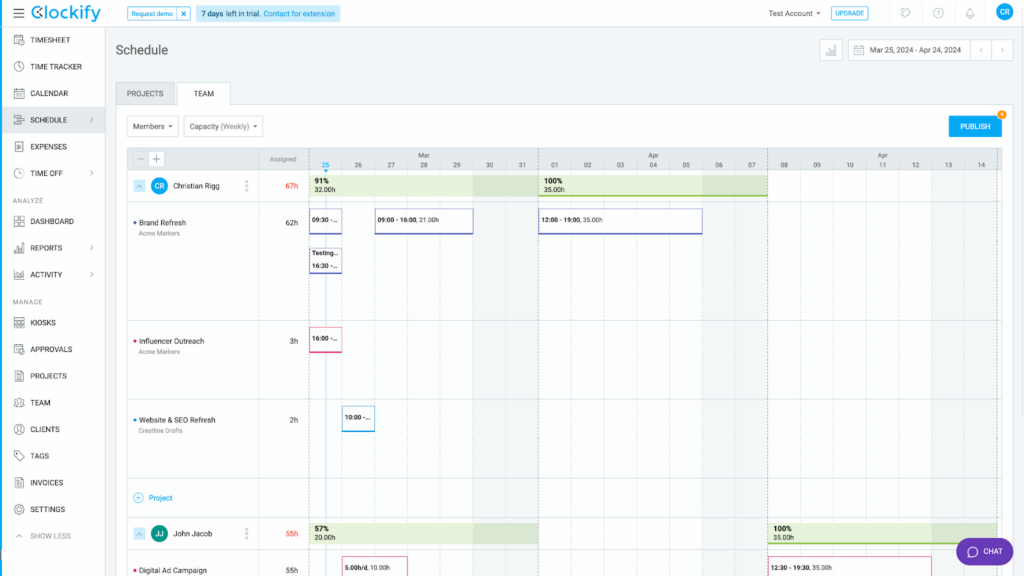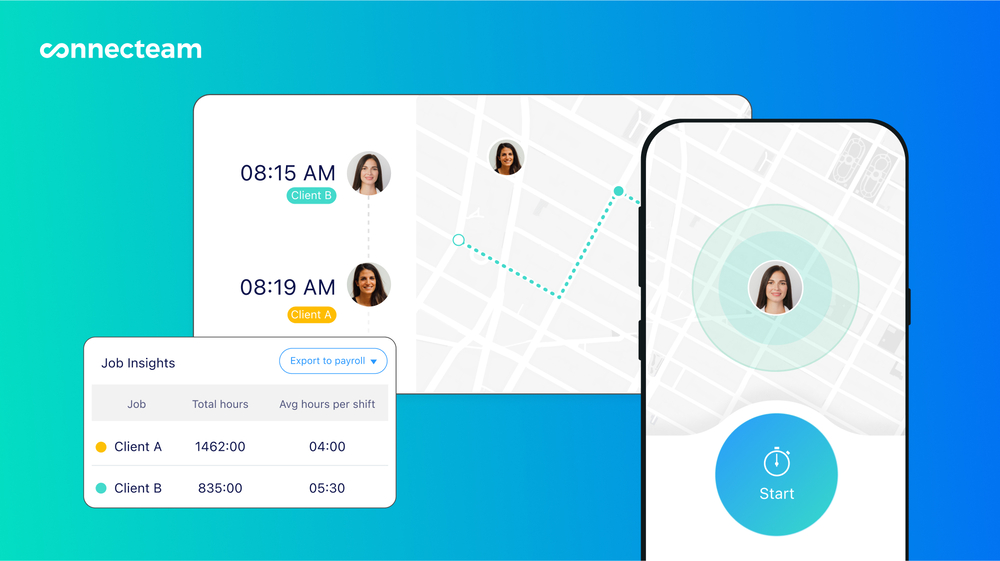Clockify and Hubstaff are leading time-tracking platforms built for hybrid and field teams. I compared their features, usability, and pricing to find out which one gives businesses stronger control and better long-term value.
Choosing the right time-tracking tool can be the difference between a smooth operation and constant frustration. Clockify and Hubstaff are two of the most trusted options for tracking hours, managing shifts, and monitoring productivity.
In this comparison, I’ll break down how each performs in key areas like GPS tracking, scheduling, and activity monitoring—and reveal a better option that solves their biggest gaps.
A note about our method: Product comparisons and verdicts in this guide are based on hands-on testing by our expert team. Several screenshots were taken from real use during our evaluation.
At a Glance: Quick Summary
Clockify and Hubstaff are two of the best time-tracking apps for office-based, onsite, and field workforces. Since they’re geared towards the same user base, their capabilities overlap on multiple fronts. However, they also have some unique features that make one better suited for your business than the other.
Clockify lets employees track time on web, mobile, desktop, browser, Pomodoro, and kiosk apps. Thanks to its nice array of time-tracking options, it supports the diverse needs of office-based and deskless workforces.
However, it lacks advanced controls like geofence, and doesn’t track breaks and overtime. As a result, it’s not suitable for businesses in regions with strict labor laws. Read our Clockify review to learn more.
Hubstaff makes up for its limited tracking options with advanced controls, such as geofencing, that help prevent time theft. Additionally, it includes robust break and overtime trackers that help businesses comply with local labor laws. Moreover, it offers employee monitoring tools like screenshot recording, app and URL tracking, and smart productivity notifications. Learn more in our full Hubstaff review.
Pricing and Plans
| Plan Type | Clockify – Monthly/User | Hubstaff – Monthly/User |
| Free Plan | Yes — unlimited users
| ❌ |
| Paid plan | Basic – $3.99/user/month
| Starter – $4.99/user
|
| Paid plan | Standard – $5.49/user/month
| Grow – $7.50/user
|
| Paid plan | Pro – $7.99/user/month
| Team – $10/user
|
| Paid plan | Enterprise – $11.99/user/month
| Enterprise – $10/user
|
*All prices show the monthly cost when billed annually as of November 2025.
Clockify and Hubstaff offer excellent pricing flexibility and scalability thanks to their user-based models. They also support a proration policy. If you add users in the middle of the month or year, you’ll be charged a prorated fee for the extra seats based on the time you added them and the remaining time on the plan.
Additionally, Clockify has a free plan with unlimited users and essential time-tracking tools. It also offers a 7-day free trial that lets you test the premium features on its paid plans. Hubstaff, by contrast, doesn’t offer a free plan. However, it provides a 14-day free trial and a 30-day money-back guarantee, giving you more time to test the app.
Their paid plans are on the lower end of the pricing spectrum, which is great for small teams on a tight budget. Beyond the standard plans, Clockify offers a kiosk plan that lets companies pay less for users who access the software only via the kiosk app. For example, the Pro plan costs $1.59 on kiosk pricing, which is about $5 cheaper than standard pricing.
That said, you have to upgrade to higher plans to access premium features with both software. However, Hubstaff offers paid add-ons like Tasks, Location, and Insights. The add-ons let all users access these advanced tools at an additional cost, regardless of their plan.
Pros and Cons
The following pros and cons highlight the strengths and weaknesses of both Clockify and Hubstaff.
Clockify Pros
- Excellent time tracking options
- Robust employee scheduling
Clockify Cons
- Doesn’t support geofencing
- Lacks proper break and overtime trackers
Hubstaff Pros
- Powerful activity monitoring tools
- Supports geofencing, break, and overtime
Hubstaff Cons
- No kiosk mode
- Lacks advanced scheduling options
Use Cases
Clockify and Hubstaff have almost the same features, but they differ slightly, making them better suited to different use cases.
Clockify is best for:
- On-site time tracking: Clockify offers a range of options, including web, mobile, desktop, and browser extensions. Its kiosk app makes it ideal for employers who want on-site employees to clock in/out on a shared device.
- Productivity monitoring: Clockify lets you track how employees spend their work hours across tasks and projects. It also offers a Pomodoro timer to keep workers focused and accountable throughout the day.
Hubstaff is best for:
- Employee productivity monitoring: Hubstaff’s screenshot monitoring, activity tracking, and smart notifications give you visibility into employees’ work habits. The insights enable you to monitor employee productivity across remote workflows.
- Billable time tracking: Hubstaff clocks employees in/out as they interact with the geofence, making it ideal for tracking billable hours.
Side-by-Side Feature Overview
Clockify and Hubstaff are undoubtedly top-tier time-tracking tools, packed with essential features. In this section, I’ll walk you through their similarities and differences to help you decide which app best fits your team. Read on for the complete breakdown.
User-friendliness — Winner: Tie
When comparing Clockify and Hubstaff user-friendliness, I focused primarily on how easy (or difficult) it is to perform various tasks. What I liked was that both apps’ user interfaces (UIs) are well-organized, which makes navigation easier. Even so, they both take unique design approaches that impact how quickly users can adapt.

When our testers last tinkered with Clockify, they found its UI crammed with key features and options that can be overwhelming for first-time users. However, the app keeps all features where modern users expect them. This streamlines navigation, enabling users to perform various tasks quickly.
Hubstaff, on the other hand, offers a clutter-free, beginner-friendly UI that removes the learning curve for newbies. Whether the employee is using the web or mobile apps, they can easily track time, stay on top of schedules, and manage availability, without ever needing to get up to speed with guides.
Verdict: Both Clockify and Hubstaff are a joy to use for managers and employees alike. The only difference is that Clockify’s UI is choke-full of details, whereas Hubstaff’s interface is clean. In my view, this difference doesn’t really give either app a clear edge, which is why this category ends in a tie.
Time tracking — Winner: Tie
During my testing, both apps tracked regular work hours exactly as they say on the tin. In other words, their available features perform to the best of their abilities. However, I uncovered some striking differences in break and overtime tracking that put clear daylight between the apps.
Clockify supports the diverse time-tracking needs, thanks to its web, mobile, and desktop apps. It also offers a web-based Pomodoro timer and browser extension for Chrome, Firefox, and Edge. Additionally, there’s a kiosk app that enables multiple employees to clock in/out on a shared smartphone, tablet, or desktop device.
Unfortunately, Clockify falls short in break and overtime tracking. Our testers noted its lack of options to set break and overtime thresholds, which makes Clockify unsuitable for businesses with strict compliance needs.

Hubstaff, by contrast, is quite apt at tracking breaks and overtime in full compliance with local labor laws. Its flexible break policy lets you create and enforce rest and meal breaks with ease. Moreover, its prompt break reminders enable employees to start and end breaks on time. However, it doesn’t prevent early returns from breaks, which can cause violations.
Regarding time tracking options, Hubstaff lets employees track time on the web, desktop, mobile, and Chrome extensions. It doesn’t offer a kiosk app, which can be a dealbreaker for some business owners with onsite and field employees. You also don’t get a Pomodoro time tracker with Hubstaff.
Verdict: While both apps make time tracking easy, Clockify edges out the competition with its wide range of tracking options. However, Hubstaff’s powerful ability to enforce break and overtime tracking laws even the score, leaving this category in a tie.
Geofencing — Winner: Hubstaff
Geofencing helps companies with on-site and field employees prevent time theft caused by off-site punching. It lets you erect virtual boundaries (geofences) around office blocks, job sites, and other designated work areas. The best time tracker, like Connecteam, uses geofences to prevent workers from clocking in or out when they’re outside the job site.
Hubstaff takes an entirely different approach. It clocks employees in or out when they enter or exit the geofence. This helps accurately track the time an employee spends at a specific address. As a result, it’s useful for field service companies and businesses looking to track billable hours.

Alternatively, you can configure Hubstaff geofence to notify employees to clock in or out when they enter or leave a geofenced area. This prevents missed or prolonged sessions, significantly improving timesheet accuracy for fair remuneration.
Clokify, by contrast, doesn’t offer a geofencing feature.
Verdict: Hubstaff is the outright winner in this category simply because it offers a geofence tool — a feature you don’t get with Clockify. Still, Hubstaff’s geofence lacks advanced automation. If you need a geofenced time-tracker that prevents off-site punching and automatically clocks out employees when they leave the job site, check out Connecteam geofencing.
Employee scheduling — Winner: Clockify
Clockify and Hubstaff let you organize your workers so everyone knows where and when they need to be. Just bear in mind that the scheduling functionality is only available on higher plans with both providers. This is unlike Connecteam, which allows all users, including those on the free plan, to schedule employees with ease.
Like every other scheduling platform, Clockify requires you to build the frameworks before you can assign shifts. I found it easy to create projects and break them into tasks, set milestones, add employees, and set weekly limits.

Instead of a month’s grid, Clockify lets you assign shifts on a weekly view. This view gets the job done, but doesn’t give you the big picture needed for long-term planning. That minor issue aside, the platform gives you handy tools like recurring shifts and drag-and-drop functionality to speed up scheduling.
Hubstaff, by contrast, lets you create shifts on the month grid, giving you a broader scope for proper long-term planning. I found it easy to create and assign shifts, thanks to the intuitive platform and tools like recurring shifts. However, Hubstaff scheduling looks like a work-in-progress, as it lacks vital features like drag-and-drop functionality.
Verdict: Clockify is the winner in this category because it packs more punch with handy tools like drag-and-drop scheduling. Hubstaff doesn’t keep up because it lacks the essential features I have come to expect of modern employee scheduling tools.
That said, neither platform does suffice for scheduling in busy environments where compliance with labor laws is critical. This is because, unlike Connecteam, they lack vital advanced features such as automatic conflict detectors, scheduling rules, an automatic scheduler, and shift swaps.
GPS location tracking — Winner: Hubstaff
Clockify and Hubstaff let you monitor employees’ locations on a centralized map view from the comfort of your office. I dug into the intricate details of their tracking methods and uncovered a key difference that makes Hubstaff far superior for real-time tracking.
Clockify records the location when an employee moves significantly (usually more than 500m), and when they start or stop the timer. While it still helps you track employee movement, it’s not apt for real-time location tracking. In my view, Clockify is ideal for non-urgent roles where constant monitoring isn’t necessary.

Additionally, Clockify adds GPS waypoints along employees’ routes. However, given its unusual tracking method, it records fewer GPS waypoints than most location tracking apps. Moreover, the app connects these waypoints with straight lines to create a route that doesn’t accurately reflect the actual road a mobile employee followed.
By contrast, Husbstaff’s location tracker updates employee locations every few minutes, letting you monitor their movements in real time. This makes Hubstaff ideal for roles where constant movement tracking is indispensable, such as field service, delivery, logistics, and security guard work.
Moreover, since Hubstaff tracks more GPS waypoints, it can track the actual route a field employee took. It provides detailed insights to help you verify whether a door-to-door sales rep or field service tech visited all assigned addresses. You can also use the data to ascertain whether employees are strictly following assigned routes.
Verdict: Both platforms track location and movement only when the employee is on the clock. This safeguards employee privacy while avoiding any legal trouble. However, Hubstaff has the edge because it tracks location in real time and provides a turn-by-turn route for a mobile employee.
Employee activity monitoring — Winner: Hubstaff
Both platforms can capture screenshots to provide insights into how much time employees spend on personal and work-related tasks. However, Hubstaff gives you more control over screenshot recording. While Clockify records a screenshot every five minutes, Hubstaff can take a screenshot at a customizable interval, usually 1x, 2x, or 3x every 10 minutes.
Image: https://connecteam.com/wp-content/uploads/2024/06/image-17-768×524.png

Additionally, Clockify’s screenshots are blurred and low-resolution by default to safeguard user privacy and security. Hubstaff, on the other hand, takes clear screenshots by default. However, you can configure it to blur screenshots to prevent sensitive information from being exposed.
Beyond screenshot recording, Clockify has an Auto-tracker that tracks the time an employee spends across websites and apps. The only minor issue is that it records URLs and apps a user views for more than 10 seconds. Any app used less than that won’t show up. Additionally, users have to manually convert the auto-tracker’s data into timesheets, which can be tedious.
Hubstaff’s website and apps tracker records every session, including those shorter than 10 seconds. It also shows how many times the employee has opened a particular app, which is useful for probing desktop activity. Moreover, it attributes the app and URL time to a specific project. This eliminates the need to manually convert those entries into timesheets.
What’s more, Clockify has an idle detection tool that helps pinpoint when an employee was away from the computer. Hubstaff doesn’t have a similar tool, but it tracks activity levels based on a percentage of keyboard and mouse strokes. It also provides weekly notifications to alert you to suspiciously high or low activity levels.
Verdict: While both apps cover the basics well, Hubstaff has the clear edge, thanks to its depth and controls. It has a more flexible screenshot recorder, an advanced app and URL tracker, and smart productivity notifications. Keep in mind that their activity monitoring features are only available on desktop apps.
Time-off management — Winner: Hubstaff
Hubstaff supports both fixed and hourly accrual PTOs for paid time off, making it suitable for diverse work patterns and internal policies. The annual accrual is very flexible. It lets you add leave balances on an employee’s birthday or at the start of the year.
Clockify doesn’t support hourly accruals. So, while it covers the basics well, it might not be ideal for businesses with hourly workers. That issue aside, Clockify can automatically add leave days to a worker’s balance at the start of the year or month. Additionally, it offers options for tracking banked hours and time-off in lieu (TOIL).

Beyond those differences, both platforms allow negative balances and offer seamless time-off request and approval workflows. If time-off requests require approval, the apps prompt the approver via email notification when an employee submits a request. This prevents delays that lead to overlapping time-offs and staffing issues.
That said, Clockify and Hubstaff lack the advanced features you get with the best employee PTO tracking software, such as Connecteam. They don’t support blackout dates, a feature that helps you restrict time off during busy periods. Moreover, they don’t let you set a minimum notice period for leave requests.
Verdict: Both platforms are pretty adept at managing employee time off, but they are better suited for different workforce needs. In my view, Hubstaff has the leg-up on Clockify because it supports both annual (front-loaded) and hours-worked accrual PTO options.
Integrations — Winner: Clockify
Regarding integrations, Clockify has a clear edge, thanks to its extensive list of native third-party integrations. It integrates with over 80 apps, including project management and productivity software. Some of its popular integrations include:
- QuickBooks
- Jira
- Asana
- ClickUp
- Hubspot
Hubstaff, on the other hand, integrates seamlessly with over 30 third-party applications. While decent by time-tracking niche standards, it still ranks second to Clockify’s array. Some of its most notable integrations include:
- Asana
- ClickUp
- Payoneer
- Gusto
- Wise
The differences aside, both solutions support Zapier integrations. I like Zapier integrations because they let you connect the software to virtually any third-party app, without coding. Moreover, Clockify and Hubstaff support Application Programming Interface (API) integrations.
Verdict: Clockify is the clear winner in this category, based on the sheer number of native integrations it supports. However, despite coming in second, Hubstaff integrates natively with popular payroll and accounting software, unlike Clockify.
User Ratings
Both Clockify and Hubstaff have garnered impressive ratings across multiple review sites. This indicates that both current and past users are satisfied with the services. Here are the products’ ratings on Capterra and G2 Crowd:
Clockify
- ⭐ 4.8/5 on Capterra (9,211 reviews)
- ⭐ 4.5/5 on G2 (185 reviews)
Hubstaff
- ⭐ 4.6/5 on Capterra (1,583 reviews)
- ⭐4.5/5 on G2 (1,519 reviews)
Security & Compliance
| Category | Clockify | Hubstaff |
| Data Encryption | ✅ | ✅ |
| GDPR Compliant | ✅ | ✅ |
| HIPAA-Compliant | ❌ | ❌ |
| SOC 2 Type 2 Compliant | ✅ | ❌ |
| 2FA | ✅ | ✅ |
| Hosting Region | US/EU/Australia | US/EU |
Both Clockify and Hubstaff offer robust data protection, even though their security measures differ slightly. Hubstaff uses the virtually unbreakable AES 256-bit encryption to protect data at rest and in transit. Clockify, by contrast, uses 256-bit SSL encryption to protect data in transit. It also hosts data on AWS servers, which are generally regarded as secure.
Regarding account security, both apps support two-factor authentication (2FA). 2FA adds an extra layer of account security on top of email password login. Beyond that, Clockify has a slight edge because it is SOC 2 Type II compliant, unlike Hubstaff. This means that its security and privacy measures have been audited and proven effective.
Setup and Onboarding
Hubstaff’s guided setup saved me hours of manual hassle. It allowed me to set up everything in one place rather than jumping across different tabs. This expedited the setup process, enabling me to get my team up and running in under 10 minutes. It also served up a short walk-through video to flatten the learning curve.
Likewise, creating a Clockify account took less than a minute during our testing. However, setting up the team and essential features took a bit longer than with Hubstaff. This is because the app doesn’t come with a guided setup. As a result, you have to switch between numerous tabs to set up the basics, which wastes precious minutes.
Additionally, Clockify doesn’t provide video or text walkthroughs. Instead, it lets users explore the platform on their own, which can be intimidating for tech-shy employees. That issue aside, Clockify offers an array of get-started tutorials to ease the learning curve.
Support and Customer Service
| Support Type | Clockify | Hubstaff |
| 24/7 Chat | ✅ | ✅ |
| Phone Support | ✅ | ✅ |
| Email Support | ✅ | ✅ |
| Help Center | ✅ | ✅ |
On the surface, the support options for Clockify and Hubstaff are identical. When you hit a snag, you can find help via live chat, phone, email, and knowledge base. However, when you dig more into each vendor’s responsiveness across these channels, their differences start to emerge.
When our testers put Clockify chat and email support through the wringer, they were overly impressed by the experience. The agents were very responsive, friendly, and helpful. In most cases, they responded to live chat queries within 3 minutes. Moreover, we usually received an email response in under an hour, which was impressive.
Hubstaff was the opposite. While they promised to offer 24/7 live chat support, my questions went unanswered. The story was the same when I launched the queries via email. However, this wasn’t surprising considering I was on the free plan, which doesn’t support both support options.
🏆 Who Wins: Clockify or Hubstaff?
| Choose Clockify if you… | Choose Hubstaff if you… |
| You own or manage an on-site team, and want employees to clock in/out on a shared device. | You’re part of a field-based business looking to monitor field employee location and movement. |
| You’re part of a project-based team and want to assign tasks and track progress. | You’re part of an office-based, remote, or hybrid team and need deep monitoring and oversight |
| Read our in-depth Clockify review | Read our in-depth Hubstaff review |
Our take:
Clockify and Hubstaff each hold their ground, but in different ways. Clockify fits teams that need simple, flexible time tracking across devices without going deep into analytics. Hubstaff, meanwhile, suits those who prioritize oversight — from GPS tracking to productivity monitoring and compliance controls.
Still, both tools have limits. Clockify lacks proper break and overtime tracking, making it less practical for businesses that operate under strict labor laws. Hubstaff’s edge in compliance and monitoring comes at the cost of usability — it can feel heavy, and its scheduling tools don’t go far enough for shift-based teams.
Both apps are capable in isolation, but they don’t complete the picture. Once time tracking, scheduling, and compliance need to work together, the gaps between them start to show.
Connecteam vs Clockify vs Hubstaff
If you’re looking for a solution that blends Clockify’s time tracking options with Hubstaff’s robust compliance, Connecteam checks all the boxes.
Connecteam isn’t just a middle ground between the two apps. It’s an advanced option that rounds out their best features with advanced scheduling and time-off tracking, eliminating gaps that slow your team down.
| Connecteam | Clockify | Hubstaff | |
| Time tracking with GPS | ✅ | ✅ | ✅ |
| Geofencing | ✅ | ❌ | ✅ |
| Scheduling | ✅ | ✅ | ✅ |
| Open shifts and shift swapping | ✅ | ❌ | ❌ |
| Free plan | ✅ Up to 10 users | ✅ Unlimited users | ❌ |
| 24/7 support | ✅ 24/7 live chat | ✅ 24/7 live chat | ✅ 24/7 live chat |
Let’s explore some of the benefits of using Connecteam:
Advanced GPS time tracking
Connecteam’s time tracking combines the best of Clockify and Hubstaff. Users can track time on a web, mobile, and kiosk app. Its kiosk app works seamlessly on mobile devices, eliminating the need for a substantial upfront fee to set up a clocking station.
Additionally, Connecteam has powerful break and overtime trackers that take the hassle out of compliance. Unlike Hubstaff, it includes an option to prevent employees from returning early from breaks, averting potential violations. Moreover, its overtime tool tracks advanced types, such as holiday and seventh-consecutive-day overtime.

Like Hubstaff, Connecteam has a geofencing tool. However, its geofence prevents employees from clocking in/out when outside the designated job site. I also like its ability to automatically clock out employees when they leave the job site. These options prevent time theft, ensuring you pay employees for the time they spend on the actual job.
Advanced scheduling options
Unlike Clockify and Hubstaff, Connecteam’s scheduling app is built specifically for dynamic, shift-based teams. It simplifies scheduling with a drag-and-drop tool, recurring shifts, and automatic conflict detectors. You can also predefine scheduling rules to ensure each schedule is compliant with labor laws and internal policies.

My favorite feature is Connecteam’s AI-powered auto-scheduler. This feature puzzles employee availability, qualification, and staffing needs to create optimal, conflict-free schedules in minutes. Assigning shifts based on employee qualifications boosts satisfaction, which, in turn, improves productivity and the quality of work.
What’s more? Connecteam offers self-service tools that let employees swap shifts and find replacements when life happens. Employees can also mark unavailability to help managers assign shifts to only available team members. This prevents scheduling issues that cause no-shows and staffing issues.
Excellent customer support
Another area where Connecteam outshines both Clockify and Hubstaff is customer support. Support is available via a help center, 24/7 live chat, phone, and email. What gives Connecteam the edge is that these channels are available to all users, including free users.
Every time I put Connecteam’s support to the test, I marvel at the responsiveness of its human agents. On live chat, for example, support agents always respond in under a minute, which is impressive. Moreover, agents are well-conversant with the various topics, so they usually provide exceptional, personalized responses.
Connecteam also offers a paid support option called Connecteam Pros. This is for you if you need help with setting up and customizing the software to your exact needs. Connecteam connects you with a certified partner who configures the solution to unlock all features, helping you to get maximum value from day one.
Unlike Clockify and Hubstaff, Connecteam gives you the flexibility to scale your business without locking essential features behind expensive plans or add-ons. Start small with the free plan to track time, create schedules, and manage your workforce without paying a dime. Plus, once you outgrow the free plan, Connecteam’s affordable plans let you transition smoothly.
FAQs
Yes, Clockify takes one screenshot every five minutes when you’re logged in.
The main difference is that Hubstaff emphasizes workforce monitoring with advanced screenshots, GPS tracking, and compliance features. Clockify, on the other hand, focuses on simple time tracking and scheduling.
Yes, Clockify offers a free plan that supports unlimited users and essential time tracking features.
No, Hubstaff doesn’t log keystrokes. Instead, it only checks if there’s mouse of keyboard activity for accurate active and inactive period tracking.

